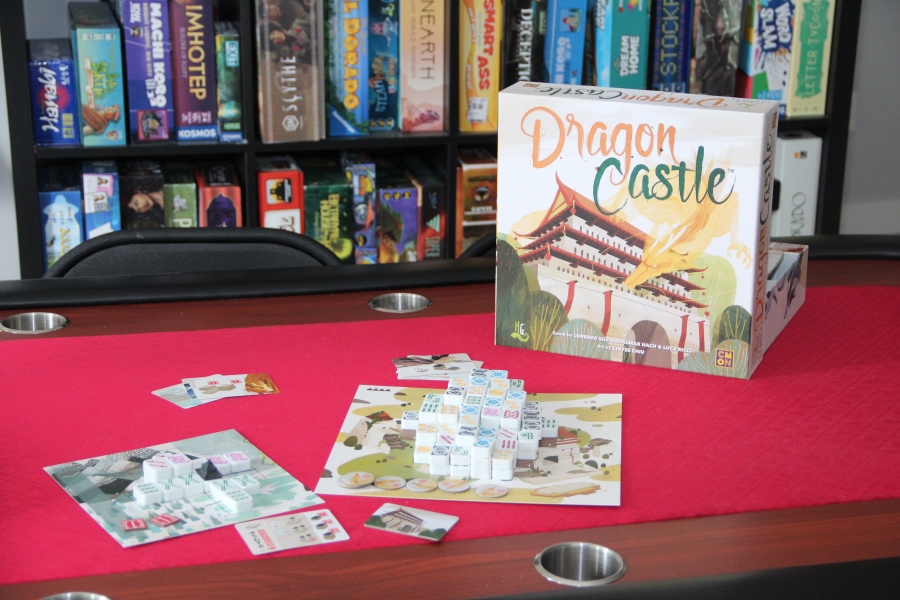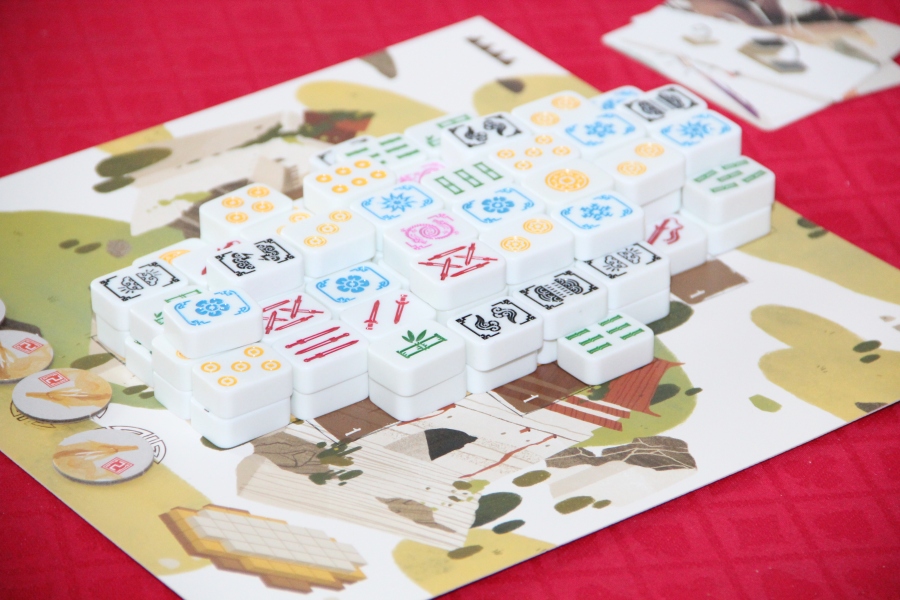Published in 2017
Created by Lorenzo Silva, Hjalmar Hach & Luca Ricci
Published by CMON and Horrible Games
No. of Players: 2 – 4
Playtime: 30 – 45 minutes
Age: 8+
Do you remember that Windows 95 game Mahjong? You know, the game where you’re given a tower of mahjong tiles and you’re trying to clear them by matching up pairs? I remember trying to play it when I was a kid with essentially no idea how. I always assumed that as long as there was a match, then you could remove the tiles. I would get frustrated when I click two tiles that are clearly the same and the game makes you feel stupid because you can’t remove any of these tiles. Only recently I found out that the reason why you couldn’t remove the tiles was because a long edge had to be exposed to the outside. I figured this out by playing this new board game recently published by CMON.

Dragon Castle is a tile laying game created by Lorenzo Silva, Hjalmar Hach & Luca Ricci, with the artwork done by Cinyee Chiu and is published by Cool, Mini, or Not. In this game, you are a lord of a nearby realm and are trying to build a castle that appeals to the Elder Dragon. You build this structure by taking Mahjong tiles from the Dragon Castle and place it on your own land. Players try to gain points by laying tiles into groups, placing shrines, and appealing to the Elder Dragon. The player who can collect the most points wins.
Setup is pretty simple, but it does take a bit of time when you are first stacking the mahjong tiles. First, place the Dragon Castle mat onto the center of the table, and shuffle and stack the provided mahjong tiles face up into the configuration indicated by the mat (a piece of advice, work from the inside towards the outside when building the castle). Next, place the countdown tokens on their indicated spots on the Dragon Castle board, and place the victory points and shrines that look like black roofs next to the board, within reach of all players. Next, hand out a player board to everyone. You can also play with the optional spirit card and dragon elder card by randomly selecting one of each and playing it face up for everyone to see. Finally, determine your first player by figuring out who saw a dragon last, (the box art does not count) and you’re ready to go.
The general gameplay of Dragon Castle is to take tiles from the main castle, and then place them on your realm. Legal tiles are any tile where at least one of the longest sides are not adjacent to another tile. There are four possible actions that you can take. (1) You can take a pair of matching legal tiles. One has to be on the topmost floor and the second can be anywhere in the castle. Place these two tiles into your castle. (2) You can take a legal tile from the topmost floor and a shrine, adding the tile to your castle, and adding the shrine to your personal pool. (3) You can discard a legal tile on the topmost floor and get a point. (4) Take a countdown token worth two points provided that the only tiles available are on the bottomost floor. If you are playing with a spirit card, you may discard a tile from the topmost floor and spend a shrine in your available pool to use that special action.
When you place the tiles you’ve acquired onto your own player mat, you can put them on a free space, or on a tile that has been flipped face down. When four or more tiles are orthogonally adjacent, then you must consolidate the tiles by flipping them face down. The more tiles you flip, the more points you get. Then you may place a shrine on top of your face down tiles, depending on which tiles you flip. These shrines are worth points at the end of the game. The higher you build the shrine, the more points you earn.

When all that remains is the first floor of the Dragon Castle, players can now take the rightmost countdown token for two points. If the exclamation point is exposed, this signals the end of the game, at which point, the player who is to the right of the first player will get to play last so that all players get an equal number of turns. Add up the points you earned from consolidating tiles with the end game points earned from both shrines and fulfilling the requirements found on the Elder Dragon bonus card. The one who has the most points wins, with ties being broken first by the most stacks of tiles with a face down tile and then by most shrines in their realm.
This game surprised me in a good way. To be honest, the original reason why I wanted to purchase this game was because it paid homage to a game I played in the 90’s on my computer. However, after playing Dragon Castle, it was much more than that. Initially the game moves slow, because you really have an open board to work with and tiles can be placed anywhere. It’s when you see your opponents’ castles that you start to consider what tiles to collect. Dragon Castle at its core is not just a tile laying game, but a set collecting game, and like most set-collecting games, you are starting to watch what other players are doing as you don’t want to be in a market where other players are. This was displayed easily by the consolidation rules, and how you flip over the tiles. It allowed me to focus only on the face up tiles of players’ castles and see what tile they’re most likely to get. For example, if I see a lot of bamboo on my opponent’s castle, then I may want to stray away from those tiles.
On that note, player interaction is a huge factor in determining strategy. This game can be cutthroat if you make it. For example, if I notice that one of my opponent’s is needing two circle tiles to complete a massive consolidation, I might just want to take those tiles and put them in my castle to prevent them from scoring. I might want to also prevent certain tiles from being exposed by not taking certain tiles, or taking only one tile and a shrine or point. The end game also addresses this in that players now have control of when the game will finish. This is one of those games that you have to constantly change strategy and decision making because of how player’s will interact with the Dragon Castle.
The components of this game are outstanding. The tiles are chunky and sturdy; they almost mimic an actual mahjong tile. The boards and tokens are of good quality and feature beautiful artwork that has a storybook feel to it. The only small problem I find (and honestly I don’t think you can alleviate this problem) is that when you are trying to take tiles off the castle, it’s pretty easy to knock things down and put things out of place. That being said, this really will not deter you from an amazing gaming experience playing Dragon Castle.

Dragon Castle is a worthwhile game to purchase. It is a beautifully crafted game with subtle strategic gameplay. While playing, the game feels light and simple to play. On top of that, with the different configurations of the Dragon Castle provided by the rulebook, and the different combinations of Elder Dragon and spirit cards, this game has a high replayability. You can also change the difficulty by incorporating more spirit and dragon cards during your game. I am shocked by the fact that the designers found a way to take a mundane computer game into something that is highly interactive with other people. Dragon Castle is definitely a game you want to add to your game collection.
Pros:
- Beautiful artwork and sturdy components
- Easy to teach
- Strategic gameplay that can either go in a peaceful or cutthroat direction, thus appealing to many audiences.
- Great if you liked playing the ol’ school Mahjong game.
Cons:
- Sometimes was difficult to grab tiles off the board
- Awful if you hated playing the ol’ school Mahjong game.


